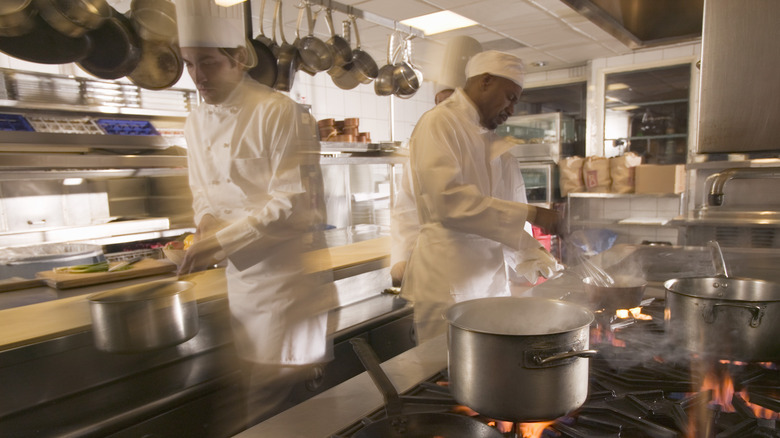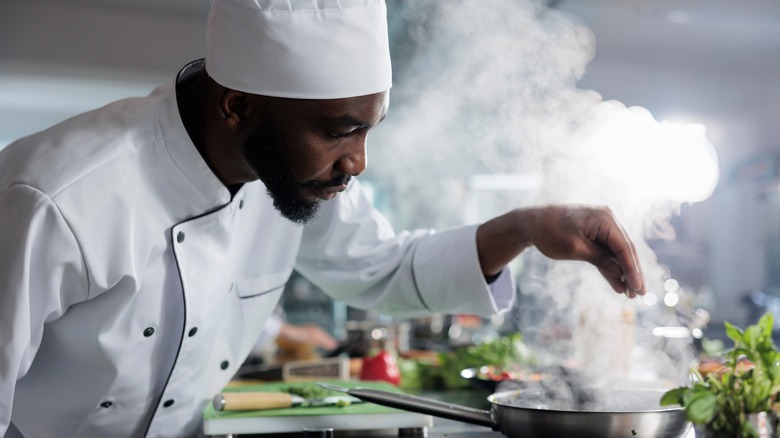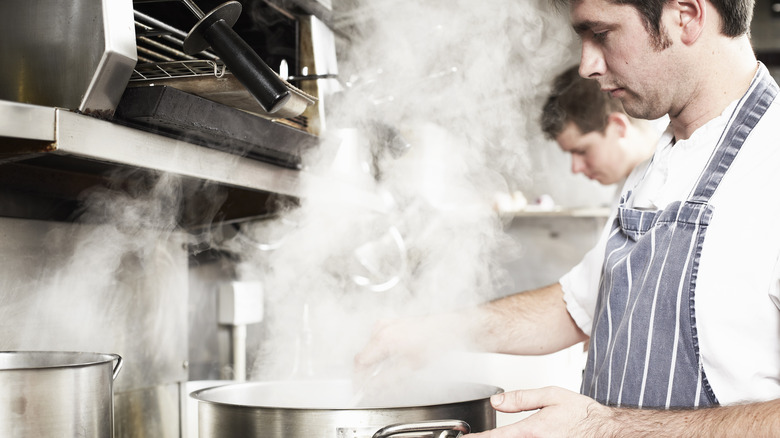What It Means When A Chef Asks For A 'Robocop' Or 'Salamander'
If you find yourself in a kitchen with a professional chef and they ask where the "robocop" is, don't panic. (A half man/half machine policeman isn't about to kick down the door saying, "Dead or alive, you're coming with me!") Your culinary cohort just needs a food processor.
As in most industries, professional kitchens and restaurants have some inside lingo. Time is always short in the kitchen, and there can be several languages being spoken at any given moment in a busy restaurant. As a result, almost anything (and anyone) can pick up a nickname.
It's easy for a newcomer (aka a "commis" — per Le Cordon Bleu) to get a little lost in translation. But picking up a few universally accepted restaurant terms, including "robocop" and "salamander," could earn you a little street cred with the chef — or just help you follow along with the next season of "The Bear."
Where does the lingo come from?
Much of the most universally recognized kitchen lingo terms come from French tools and training, and "robocop" is a good example. The word is most likely a mondegreen — that is, as The New Yorker explains, "a misheard word or phrase that makes sense in your head, but is, in fact, entirely incorrect." The word comes from the French company Robot-Coupe, which, according to Forbes, started making industry-exclusive food processors in 1963. The appliance found in almost every kitchen got a new moniker somewhere around the 1987 release of the film "RoboCop," and it's never been the same thing since.
A salamander, on the other hand, has more ancient origins. If a chef tells you to put something in the salamander, don't go looking for a small lizard. Food Lore describes a kitchen salamander as a self-contained broiler that's used to finish or brown dishes. It's often where your food goes if it's being "refired" (the dish is returned for being undercooked) or made "on the fly" (aka made quickly, according to Toast). The name, according to A Way With Words, comes from a mythical beast that was impervious to fire. Chefs refer to it as such because it's the hottest spot in the kitchen — up to 1,500 F (per Paste), which makes it perfect for quick-broiling fish, as in recipes for tuna nicoise.
Get the lingo down
Feeling like you're ready to join the brigade? That's the French term for the kitchen hierarchy system (per Le Cordon Bleu). Here are a handful of more must-know terms to drop next time you're sitting at the chef's table.
"Mise" is short for mise en place, the French term for prepping and assembling your ingredients. "All day" denotes a count of items in a restaurant — either what's available to sell or what a cook has on order. For example, the expeditor, who runs "the pass" where orders come in (per Jancis Robinson), may call multiple tickets to the line at the same time. To make sure they "fire" (start cooking) enough to cover the tickets, a cook will ask, for example, "How many lamb all day, chef?"
When something runs out in a restaurant — a dish, an ingredient, patience for a customer — it's "86'd." Insider explains that this term comes from Prohibition-era Manhattan, where the bar Chumley's had two entrances, one on Pamela Court and the other on 86 Bedford Street. When they were tipped off to a raid, customers used the 86 exit.
And "burn the ice" has become such a universally recognized kitchen term that it's the title of James Beard Award-winning food journalist Kevin Alexander's 2020 food memoir. At the end of a shift, it's against health code to leave ice in a bartending well or in sinks, so a cook or bartender will run hot water over the ice until it's melted.


